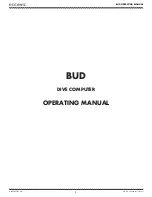
BEDIENUNGSANLEITUNG
KONDENSATIONSWÄCHTER
Type: SERIE EE45
MANUAL
CONDENSATION MONITOR
Type: SERIES EE45
MANUEL D'UTILISATION
DETECTEUR DE CONDENSATION
Type: SERIE EE45
ALLGEMEIN:
Der Kondensationswächter der Serie EE45 ist für die frühzeitige
Erkennung der Betauungsgefahr bestimmt.
Das Gehäuse ist für eine Montage an Rohrleitungen und als
Wandmontage geeignet.
Beim Erreichen des Schaltpunktes von 90% rF schaltet der Ausgang um
und liefert somit frühzeitig ein Signal für die Einleitung von
Gegenmaßnahmen (Erhöhung der Wasservorlauftemperatur, Senkung
der Kühlleistung, Einschalten der Heizung, etc...).
Anwendung findet die Serie EE45 in Kühldecken und in Heizungs-,
Lügtungs- und Klimaanlagen.
ACHTUNG:
Extreme mechanische und unspezifizierte Beanspruchungen sind
unbedingt zu vermeiden.
Beim Sensorelement handelt es sich um ein ESD gefährdetes Bauteil.
Bei Wartungsarbeiten sind die einschlägigen ESD-Schutzmaßnahmen
einzuhalten.
Einsatzbereich
10...100% rF
Versorgungsspannung
SELV 24V AC ±20%
Stromverbrauch
< 10 mAeff
Schaltpunkt bei 25°C
90±5% rF
max. Schaltspannung
< 50V DC
max. Schaltstrom
< 10 mA DC
Temperaturbereiche
Ansprechzeit auf Rohr- bzw.
Wandtemperaturänderung
Betriebstemperatur: 0...50°C
Lagertemperatur:
-20...70°C
Anschluss
über 4 poliges Kabel
90±5% r F
Hysterese
5% rF
EIN
AUS
t90 < 3 min.
Ansprechzeit auf Raumfeuchteänderung t90 < 25 sek.
Langwiesen 7
A-4209 Engerwitzdorf
Austria
T: +43-7235-605-0
F: +43-7235-605-8
BA_EE45_01 // Technische Änderungen vorbehalten / technical data are subject to change / sous réserve de toutes modifications techniques // 302276
1
TECHNISCHE DATEN:
GENERAL:
The Condensation monitor of the EE45 series is used for early detection
of condensation danger.
The housing can be mounted on pipes, ducts and walls.
At reaching the switching point of 90% RH the output will provide an early
warning signal for the initiation of control steps (increasing the initial water
temperature, reducing the cooling capacity, switching on the heating,
etc...).
Common applications for the EE45 series are chilled ceilings and heating-,
ventilation- and air conditioning systems.
ATTENTION:
Absolutely avoid extreme mechanical and unspecified strain.
The sensor is an Electro Static Discharge sensitive component (ESD). For
maintenance purposes it is recommended, that you observe the valid
ESD-safety precautions!
Working range
10...100% RH
Supply voltage
SELV 24V AC ±20%
Current consumption
< 10 mAeff
Switching point at 25 degC
90±5% RH
max. switch voltage
< 50V DC
max. switch current
10 mA DC
Temperature range
Response time at change of duct
resp. wall temperature
working temperature: 0...50degC
storage temperature:
-20...70degC
Connection
4 leads cable
90±5% RH
hysteresis
5% RH
ON
OFF
t90 < 3 min.
Response time at change of rel. humidity t90 < 25 sek.
TECHNICAL DATA:
Gamme de fonctionnement
10...100% HR
Alimentation
SELV 24V AC ±20%
Consommation
< 10 mAeff
Seuil à 25°C
90±5% HR
Pouvoir de coupure max. en tension
< 50V DC
Pouvoir de coupure max. en courant
10 mA DC
Plage de température
Temps de réponse sur tuyauterie
modification de température murale
Température d'utilisation: 0...50°C
Température de stockage:
-20...70°C
Raccordement
câble 4 conducteurs
90±5% HR
Hystéré sis
5% HR
ON
OFF
t90 < 3 min.
Temps de réponse en modification
de HR ambiante
t90 < 25 sek.
DONNÈES TECHNIQUES:
GENERALITES:
Le détecteur de condensation de la série EE45 est utilisé pour la
détection préventive des risques de condensation.
Le boîtier est destiné à un montage mural ou sur tuyauterie.
Lorsque le point de consigne de 90%HR est atteint, le signal de sortie
s'enclenche et délivre une information à l'installation (augmentation
de la température de l'eau de circulation, diminution de la puissance de
refroidissement, enclenchement du chauffage, etc…).
La série EE45 est utilisée dans les applications de plafonds refroidis,
chauffage, ventilation et climatisation.
ATTENTION:
Eviter de solliciter l'appareil à des efforts mécaniques ou à une utilisation
non spécifiée.
Un risque d'électricité statique existe au niveau de l'élément sensible.
Dans le cas d'une maintenance ou d'un entretien, utiliser les protections
nécessaires à la manipulation de composants comportant des risques de
décharges électrostatiques.






















